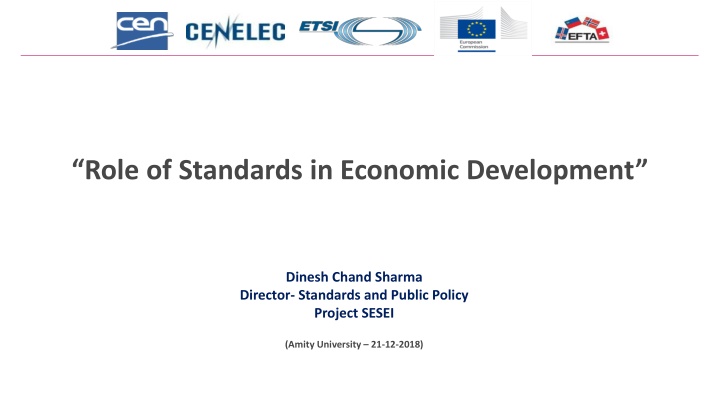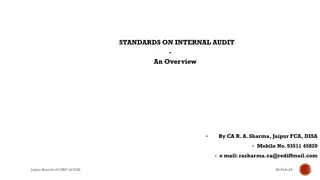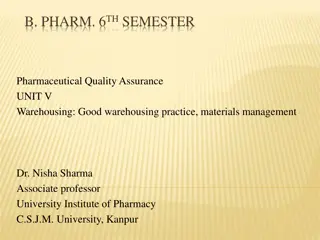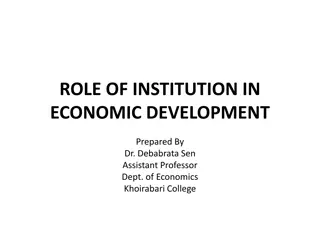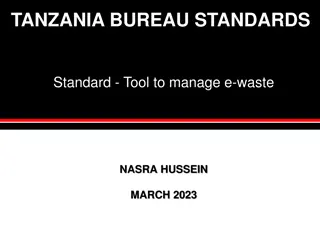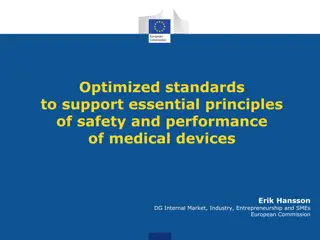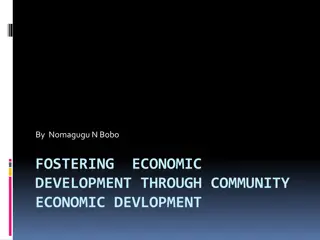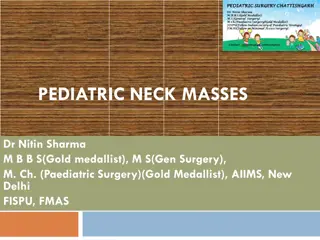Role of Standards in Economic Development by Dinesh Chand Sharma
Learn about the significance of standards in economic development through insights shared by Dinesh Chand Sharma, Director of Standards and Public Policy Project at Amity University. Discover how standards contribute to enhancing market access and navigating regulatory landscapes, with a focus on sectors like ICT, electrical equipment, automotive, and smart cities
Download Presentation

Please find below an Image/Link to download the presentation.
The content on the website is provided AS IS for your information and personal use only. It may not be sold, licensed, or shared on other websites without obtaining consent from the author.If you encounter any issues during the download, it is possible that the publisher has removed the file from their server.
You are allowed to download the files provided on this website for personal or commercial use, subject to the condition that they are used lawfully. All files are the property of their respective owners.
The content on the website is provided AS IS for your information and personal use only. It may not be sold, licensed, or shared on other websites without obtaining consent from the author.
E N D
Presentation Transcript
Role of Standards in Economic Development Dinesh Chand Sharma Director- Standards and Public Policy Project SESEI (Amity University 21-12-2018)
Outline Who am I? A brief introduction to standards Education about Standardization (EaS) How Standards helps in Economic Development Conclusion
Project is a permanent presence in India SESEI (Seconded European Standardization Expert in India) is a face for the European standardization community in India Why SESEI: India is a major trade partners for Europe, Increasing role of standards to gain market access and Evolving & complex national regulatory and standardization landscapes Sector: 1. ICT: M2M/IoT, Security, 5G, NFV/SDN, e-Accesibility, eHealth, eCALL 2. Electrical equipment including Consumer Electronics: Smart Grid, Smart Meter, LVDC, Micro- Grid, Lift Escalator 3. Automotive: Connected Cars, ITS, e-Mobility 4. Smart Cities: Mobility, Waste, Energy, ICT.. www.sesei.eu , www.sesei.in , www.eustandards.in Amity University (21-12-2018) 3
Standard? Standards are simply a way of sharing good practice. It is a document that defines technical or quality requirements with which current or future products, production processes, services or methods may comply Standards present the consensus view on products/services, managing processes or even improving behaviours. They can be agreed specifications, recommendations, guidelines or principles. They demonstrate that products/services meet agreed criteria, processes and principles. Standards are written & maintained by business/industry, consumers, govt., innovators, etc. Organizations of all sizes and across all sectors choose standards to help them achieve their goals.
Standards vs Lgislation Standards : Legislation : 1. Voluntary & Consensual 2. Developed by independent organisations 3. Revised every 5 years 4. Provide specifications and test methods (interoperability, safety, quality, etc.) 1. Mandatory & Imposed by Law 2. Established by public authorities 3. Revised when legislators decide 4. Gives requirements to protect public interests
How Standards are Made? All ideas for new standards are assessed & stakeholders are consulted on the potential scope The Stakeholder group forms a committee to draft the standards Anyone can suggest an idea for a new Standard The Proposal is assessed and if approved a stakeholder group is formed Standards are reviewed every five years some as early as two years from publication. The committee or drafting panel considers any comments they have received about standard and decides whether it needs to be withdrawn , confirmed or reconfirmed amended or revised. A decision to amend or revise the standard will lead to a new proposal for work Once the document passes final approval it is published The draft is then issued for public consultation
Integrated with International Integrated with International Objective - Avoid duplication of work at International and European levels with an aim for a identical worldwide standards Vienna Agreement with Chemistry, Material, Energy, Environment, Transport, Construction, Services, eMobility etc Founding member of ISO and working with IEC since 1911 Frankfurt Agreement with Electricity, Electro-technical MoU for telecommunications sector (ITU-T), Agreement on radio-communication sector (ITU-R) DoT/TEC are member of ITU-T and WPC for ITU-R Information & Communication Technologies (ICT) Founding Partner to 3GPP & oneM2M Organisational Partner of 3GPP and Partner Type 1 of oneM2M 7
Why EaS Business needs increasing competition New stakeholders knowledge gap Research and innovation marketization Regulation understand role of standards & laws CEN-CENELEC Guide 30 European Guide on Standards and Regulation - Better regulation through the use of voluntary standards - Guidance for policy makers Sustainable system maintain expert base Hence it is imperative that: Public authorities and educational and training organizations are aware of need for education about standardization and include relevant content in their curriculam Raise awareness & spread knowledge about standardization as a powerful tool to bring new technologies to market and drive (future) businesses.
What - EaS EaS is teaching pupils, students, CEOs, managers, employees in business, and life-long learners the subject of standards and standardization. It shall include the followings as below: The use and benefits of standards the strategic importance of standardization for business and competitiveness how to implement standards in businesses and how to participate in standardization to influence the content of future standards.
CEN-CENELEC-ETSI JWG EaS The Joint Working Group on EaS is between the Three EU Standardization bodies namely CEN,CENELEC & ETSI JWG-EaS was established as a policy on EaS (2011) with the aims of improving the understanding of the added value of standardization amongst the key stakeholders (business executives, academia, government and relevant authorities, ...); increasing the competency of those persons seeking to participate in the standards-making process. Masterplan on Education about Standardization (2012) to set up a strategy for achieving the vision set out in the Policy on EaS (2011) Model curricula was developed by JWG-EaS to be used by higher education and vocational training organizations: model curriculum for higher education (2011) model curriculum for vocational training (2012) eLearning tool for SMEs (2015) and repository of teaching tools and materials Textbook for higher education A world built on standards (2015) Boosting ICT Business and Innovation: A Comprehensive Approach to Standardization Education in Europe
Standards are important for economic growth? It is widely accepted that standards play a vital and often invisible role in supporting economic growth: by promoting productivity and efficiency in companies through their role in supporting international trade by acting as a catalyst for innovation within companies and sectors. Enhance safety of products Promote common understanding Facilitate trade by reducing TBs Promote interoperability of products and services Benefits of economies of scale Support environmental sustainability Facilitate the uptake of innovation & reflect the outcome of research and Development
Boost productivity & improve performance Increase efficiency by streamlining processes Reduce cost by minimizing waste & time spent Lower cost of regulatory compliances Allows production at scale with standardized solutions, performance or outcomes, thus freeing resources for differentiating products and services from those of competitors High Quality of Product & Services results in: buyers' confidence enhances companies' reputation Shorten time to market
Kick Starts Innovation Agree common terminology and transfer new information into the commercial environment, which accelerates the spread of innovation Support innovators by providing expert, authoritative new knowledge, which in turn becomes a platform for further innovation Build communities and promote the exchange of knowledge, which catalyzes collaborative development and speeds up technology lifecycles Encourage process innovation through continual improvement Enable organizations to unlock their full potential in terms of their products, processes and behaviors
Support Domestic & International Trade Give buyers confidence that products will be safe and fit for purpose, so they are more widely accepted Improve transparency buyers know what they re getting which reduces the costs of international trade, such as the need for repeated product testing Make firms more efficient and innovative, so they can compete globally Overcome arbitrary national technical barriers to trade Improve confidence and transparency throughout complex and often multinational supply chains
Case Study of UK Economy Review of Role of Standards from 1921 to 2015 was carried out to provide a comprehensive examination of how standards have impacted UK economic growth: Standards Contributed worth 8.2 Billion to the UK economy i.e. 28.4 % annual GDP 6.1 billion additional exports per year 37.4% growth in productivity attributed to standards SMEs are 41% more likely to export if they use standard based products/ services Large Companies are 36% more likely to export with the adoption of standards Source : Centre for Economics and ( Cebr) Business Research
Case Study of Nordic Economy Menon Economics in cooperation with Oxford Research and the Social Science Research Institute of the University of Iceland carried out study - THE INFLUENCE OF STANDARDS ON THE NORDIC ECONOMIES By doubling the stock of standards increase of 10.5 percent in labour productivity across the Nordic countries. Given the average growth in stock of standards in the Nordic countries of 6.8 percent during the period studied (1976-2014): Standardization is associated with an annual increase in labour productivity of 0.7 percent per year of a total average growth of 1,8 percent. This result suggests that standardization is associated with as much as 39 percent of the labour productivity growth and 28 percent of GDP growth in the Nordic countries during the period. The most important reason for companies to use standards is to improve market access (34 percent of respondents), improve product/service quality (32 percent of respondents) and reduce risk (26 percent of respondents). Source : Report THE INFLUENCE OF STANDARDS ON THE NORDIC ECONOMIES
Conclusion Standardisation is a form of self regulation and is a tool to create markets as large and homogenous as possible to allow for economiesofscale Compliance with standards in support of regulation/legislation implies the right to place a device on the market , that is to offer it for sale ICT Standards need to be global considering the fact of interoperability Standards Portfolio Harmonization with Global Standards, raising awareness and visibility plays an important role in strengthening trade Educational and training organizations must be aware of need for education about standardization and include relevant content in their curricula Standards helps in Boosting productivity, improve performance, Kick Starts Innovation and help in Domestic & International Trade 19 Amity University (21-12-2018)
Dinesh Chand Sharma (Seconded European Standardization Expert in India) Director Standardization & Public Policy SESEI C/O EBTC, DLTA Complex, Gate No 3, 1st Floor, 1, Africa Avenue, New Delhi 110029 Mobile: +91 9810079461, Tel: +91 11 3352 1525, dinesh.chand.sharma@sesei.eu www.sesei.eu www.sesei.in 20 Amity University (21-12-2018)
